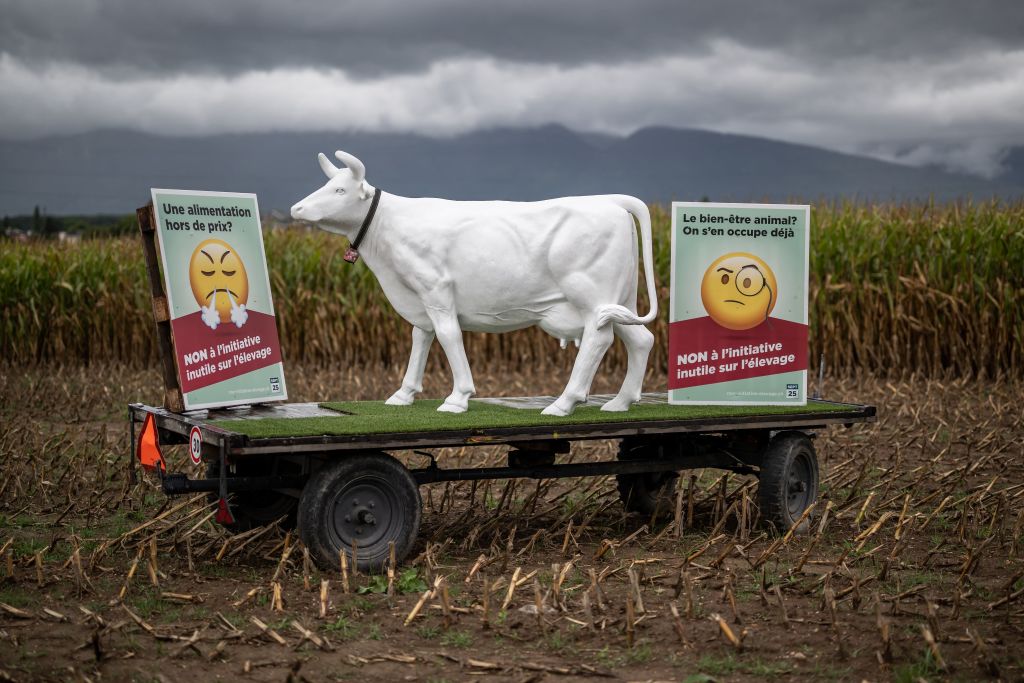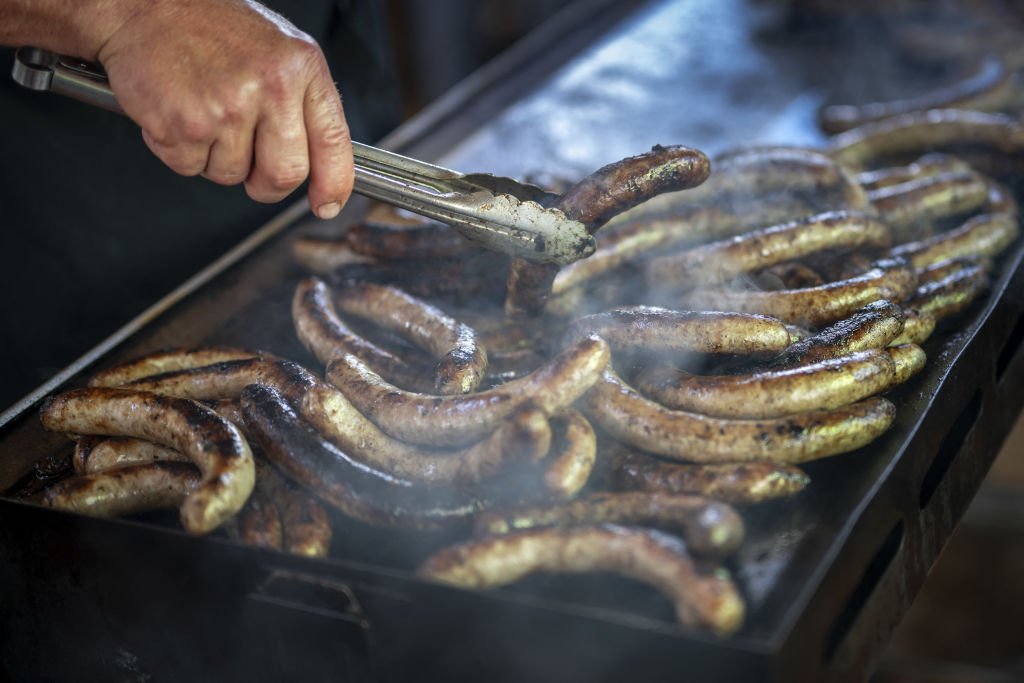
By many measures, Ueli Stauffacher’s poultry farm is exemplary. Located about 30 minutes southwest of Zurich, the chickens it raises for meat (called broilers in agricultural parlance) are housed in two spacious, well-kept barns. One of those barns is outfitted with heated floors that keep the birds’ bedding dry and a state-of-the-art filtering system that strips away the overpowering smell of ammonia that typically characterizes chicken farms, leaving the air inside remarkably sweet and clean. Solar panels on the roof generate enough electricity to power the whole farm renewably. Stauffacher and his wife even host playgroups at the farm, complete with a brightly-decorated break room where children can watch the chickens through a window as they color and enjoy snacks.
Yet the 40-year-old farmer fears he may soon be forced to either dramatically change how he raises birds, or shut down his farm altogether. On Sept. 25, the Swiss go to the polls to vote on an addition to the federal constitution that would, in a global first, ban intensive, or “factory,” farming. If the proposal passes, the 9,000 broilers that Stauffacher raises in each of his two barns will be reduced to around 2,000 total , and he will either have to build a lot more barns or reduce his flock size significantly in the next 25 years. Neither of these options, he says, is economically viable.
Read More: How China Could Change the World by Taking Meat Off the Menu
“People don’t understand how agriculture works anymore,” Stauffacher said on one of the first chilly mornings this fall. “Forty or fifty years ago, almost everyone had someone in their family who farmed, but that conduit is gone now. So you get people saying, ‘oh, poor animals.’ But they still want to eat meat.”
That conundrum is playing out on dinner plates across Europe. On the one hand, a rising concern with animal welfare and an awareness of agriculture’s environmental impact, especially when it comes to climate change (animal husbandry contributes 14.5% of greenhouse gas emissions), has translated into a broad and growing movement to reduce meat consumption and improve the conditions under which livestock are raised. At the same time, inflation, rising energy costs, and market growth for some animal products—like the chickens Stauffacher raises, for which demand has actually risen as concerns with the environmental and health impacts of beef have grown—have only increased the pressure on agriculture to prioritize efficiency and keep prices accessible.
The Swiss campaign dovetails with—and will perhaps provide ballast for—animal rights efforts elsewhere in the West. In late August, Spain became the first country in Europe to mandate video surveillance inside slaughterhouses in order to ensure they follow best practices. Early in September, the Dutch city of Haarlem became the first to ban advertisements for meat. In the spring of this year, Arizona became the latest state in the U.S. to ban battery cages for hens, and at the European Union level, a citizens’ petition for a similar measure, led by the organization Compassionate World Farming, garnered the necessary 1 million signatures from across the 27 member states to trigger a proposal from the European Commission (EC) next year. In fact, notes Alice di Concetto, founder of the European Institute for Animal Law and Policy, the European Commission is taking the opportunity of the cage proposal “to revise all EU farm animal welfare legislation. So there are other measures that hopefully will be included,” like chick grinding—a common egg farm method for killing male chicks soon after they hatch—and new limitations on the transport of livestock to slaughter.

That it is Switzerland taking the lead in attempting to resolve the tension by eradicating intensive farming is either ironic or unsurprising, depending on how you look at it. For anyone who equates the phrase “factory farm” with the 32,000-head feedlots that produce over 40% of the beef consumed in the United States, Swiss animal husbandry will seem almost laughably quaint. The average dairy farm has just 24 cows (versus 300 in the US and 250 in Germany). No farm, regardless of its acreage, can have more than 300 veal calves, 1,500 pigs, or 27,000 broiler chickens.
Switzerland also already has some of the toughest animal welfare regulations on the books, many of which were introduced through the direct democracy tool of popular initiatives. Its long history of animal protection laws dates as far back as 1893, when a popular initiative made it illegal to slaughter animals without first anesthetizing them. In 1978, the country passed the Animal Welfare Act, which prohibits inflicting pain on animals without justification. It has banned boiling lobsters alive, decreed that social animals like guinea pigs must be kept in pairs, and in 1996, became the first country in the world to outlaw battery cages for laying hens. (Currently 10 states in the U.S. have done the same; Denmark announced its own plan just this week.) And while a handful of other nations have enshrined the notion of animal dignity in their laws, only Switzerland protects it at the constitutional level.
Read More: Vegan Documentarian Tells the Inside Story of the Lab Grown Meat Industry
But none of that, supporters say, means there isn’t more to be done. Over the past two decades, Swiss farms have, on average, grown in size, and some aspects of the welfare law have either been watered down or left unenforced. “It’s true that we don’t have a lot of big farms in Switzerland,” says legislator Martina Munz, whose Social Democratic party favors the ban. “But we have a lot of things we can do better when it comes to animal welfare. It’s not just the number of animals in the group, it’s also about how they’re kept, it’s about slaughtering and transportation.”
Farmer Kurt Brunner practices the kind of animal husbandry that the proposal’s organizers’ would like to see. From his mixed-purpose farm located about 40 kilometers west of Zurich, Brunner and his colleagues not only make cheese from the milk of their 20 cows, raise 8 sheep, and sell eggs from their 300 chickens, but also grow the grain that feeds their livestock. Brunner supports the initiative because he has seen what the growing consolidation of farms and the commodification of their products has meant for farmers and the animals they raise. “The bigger farms in Switzerland are not so sustainable,” he says, neither environmentally nor economically. “They have no guarantee of good prices because the big dealers like Migros and Coop look for cheapest products. And there is also the problem of animal welfare. I don’t think that all of my farmer colleagues are happy with their ways of production but if the price is so low, one possibility is just to make more.”
Drafted by a coalition that includes Sentience Politics, the Green Party, and several NGOs, the proposed amendment, which allows for a 25-year transition period, requires farms to ensure that livestock have free access to the outdoors and species-appropriate housing, and that the entire slaughter process, including transport, is humane. It also mandates less dense farms, calling for the adoption of the same guidelines employed by the organization that regulates organic certification in Switzerland, Bio Suisse. Those standards limit the number of pigs in any pen or barn to 1000 and the number of laying hens to 2,000.
“It’s very much not a radical initiative,” says Ryf. “Basically, it’s just a little better welfare, so to us it seems like a no-brainer. But obviously, our opponents see it differently.”

They do indeed. The government estimates that only 3,300 Swiss farms—roughly 6.6%— will have to either significantly reduce their herds or increase the size of their animal enclosures, but that the cost of animal husbandry in general will rise. So too will consumer prices. “We already produce on a high level, and they want to put another load of laws on our shoulders,” argues Martin Haab of the farmers he represents as president of the Zurich Farmers’ Union (Haab is also a legislator, and a dairy farmer himself). “But consumers are not ready to pay a lot more for their food. So it’s kind of nuts to say we have to have a higher level of animal welfare.” Nevertheless, the market for organic products in Switzerland, according to Bio Suisse, grew 0.6%, which although slower than the 4% increase the previous year, still makes Switzerland the third largest consumer in Europe.
The proposal includes a provision that requires any imported animal products to meet the same standards as domestic ones, but critics argue the imports will still be cheaper, and that the market for meat, eggs and milk will shift toward foreign producers. In a written statement to TIME, Patrick Stöpper, spokesperson for Switzerland’s largest supermarket chain Migros, said that if Swiss farmers don’t remain competitive “consumers will increasingly cover their needs with animal products from abroad, where the level of animal welfare is sometimes much lower than in Switzerland.”
Read More: We Need to Rethink Our Food System to Prevent the Next Pandemic
Opponents also suspect that for all of its emphasis on improving animal welfare, the initiative is really intended to curb animal husbandry. “This is about meat; they don’t like people eating meat,” says Haab. “They don’t like the idea of killing an animal. That’s the point.”
Not exactly, says Sentience Politics’ Ryf. He points out that although some members of the initiative coalition are indeed opposed to eating meat, others, like the Small Farmers’ Association, depend on producing it for their livelihoods. But he agrees that the association as a whole would like to see a reduction in overall consumption. “One of the questions that’s very heavily debated is whether we will have the same output after [the initiative passes], and just need a lot more farms, more slaughterhouses, more everything, or whether it will necessitate shifting consumption patterns,” he says. “Which we actually would be in favor of.”

The latest polls—and recent history—suggest that the initiative faces an uphill climb; earlier in the year, Swiss voters overwhelmingly rejected a proposal that would outlaw animal testing, in part thanks to lobbying form the country’s powerful pharmaceutical industry. But even if it doesn’t pass, Ryf says, the farming initiative has already achieved a lot. “Every day, there are articles in the newspaper about it,” he says. “People who have never heard about the conditions in Swiss farms are now thinking about them. All the politicians have heard the specifics, all the journalists, and they probably will keep on talking about it. So this, for us, is already success.”
At the heart of all this debate lie shifting perspectives on the relationship between humans and the animals they eat, a debate shaped by technology, climate change, and evolving ethics. For all of the care and innovation evident at Ueli Stauffacher’s farm, for example, it’s also plain to see why some might be troubled by the efficiencies built into his style of raising animals for meat. Stauffacher’s 18,000 chickens are all sold directly to the supermarket chain Migros, which supplies the farm with day-old chicks to raise, and collects the grown chickens 36 days later when they are taken to slaughter. Although they have access to an outdoor pen during the final 15 days of their lives, it is covered for their protection, which means the birds spend their five weeks on earth without ever seeing open sky.
Read More: Six High Protein Foods That Are Healthier Than Beef
Perhaps nowhere were those changing perspectives clearer than on legislator Haab’s own farm. Located in Mettmenstetten, not far from Ulie Stauffacher’s poultry operation, it is home to 75 milking cows and another 70 young stock, which, in Switzerland, counts as a large dairy farm. In an idyll that would not look out of place in Heidi, the animals spend the summer on pasture in the hills about 10 kilometers away. But in winter, they return to a barn and paddock where they are milked by a robot that, after cleaning the cow’s underside with tiny versions of the roller brushes used at car washes, locates the cows teats, attaches itself to the udder, and begins sucking.
In many ways, Haab’s farm embodies the dilemma that farmers–and the people they feed—face as they attempt to navigate the tricky waters between welfare and efficiency, between the public’s unease with treating animals as, essentially, food-producing widgets, and its appetite for meat and cheese. On the one hand, it’s hard to get more industrialized than a robot. But according to Haab, if technology has made things easier, it hasn’t changed how much they care about their animals. Haab still knows the names of all his cows, even if keeping track of when Cranberry was last milked now entails nothing more than opening the app on his phone to look at the latest data sent by the automated system. Because the machine disinfects her teats before it begins milking she and the milk itself are at lower risk for pathogens. And because the cows can freely access the robot, which runs 24 hours a day, they can be milked as often as they want rather than having to adjust to the farmer’s schedule–a measure that can make the cows more comfortable. “It’s not up to me anymore; they get to decide for themselves,” he says with a grin. “Now that’s animal welfare.”
More Must-Reads from TIME
- Why Trump’s Message Worked on Latino Men
- What Trump’s Win Could Mean for Housing
- The 100 Must-Read Books of 2024
- Sleep Doctors Share the 1 Tip That’s Changed Their Lives
- Column: Let’s Bring Back Romance
- What It’s Like to Have Long COVID As a Kid
- FX’s Say Nothing Is the Must-Watch Political Thriller of 2024
- Merle Bombardieri Is Helping People Make the Baby Decision
Contact us at letters@time.com